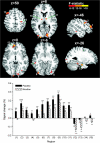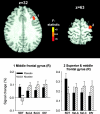Performance effects of nicotine during selective attention, divided attention, and simple stimulus detection: an fMRI study
- PMID: 19073624
- PMCID: PMC2733682
- DOI: 10.1093/cercor/bhn226
Performance effects of nicotine during selective attention, divided attention, and simple stimulus detection: an fMRI study
Abstract
Attention-enhancing effects of nicotine appear to depend on the nature of the attentional function. Underlying neuroanatomical mechanisms, too, may vary depending on the function modulated. This functional magnetic resonance imaging study recorded blood oxygen level-dependent (BOLD) activity in minimally deprived smokers during tasks of simple stimulus detection, selective attention, or divided attention after single-blind application of a transdermal nicotine (21 mg) or placebo patch. Smokers' performance in the placebo condition was unimpaired as compared with matched nonsmokers. Nicotine reduced reaction time (RT) in the stimulus detection and selective attention but not divided attention condition. Across all task conditions, nicotine reduced activation in frontal, temporal, thalamic, and visual regions and enhanced deactivation in so-called "default" regions. Thalamic effects correlated with RT reduction selectively during stimulus detection. An interaction with task condition was observed in middle and superior frontal gyri, where nicotine reduced activation only during stimulus detection. A visuomotor control experiment provided evidence against nonspecific effects of nicotine. In conclusion, although prefrontal activity partly displayed differential modulation by nicotine, most BOLD effects were identical across tasks, despite differential performance effects, suggesting that common neuronal mechanisms can selectively benefit different attentional functions. Overall, the effects of nicotine may be explained by increased functional efficiency and downregulated task-independent "default" functions.
Figures




Similar articles
-
Nicotine enhances visuospatial attention by deactivating areas of the resting brain default network.J Neurosci. 2007 Mar 28;27(13):3477-89. doi: 10.1523/JNEUROSCI.5129-06.2007. J Neurosci. 2007. PMID: 17392464 Free PMC article. Clinical Trial.
-
Nicotine modulation of information processing is not limited to input (attention) but extends to output (intention).Psychopharmacology (Berl). 2010 May;209(4):291-302. doi: 10.1007/s00213-010-1788-9. Epub 2010 Mar 23. Psychopharmacology (Berl). 2010. PMID: 20309531 Free PMC article. Clinical Trial.
-
Chronic smoking, but not acute nicotine administration, modulates neural correlates of working memory.Psychopharmacology (Berl). 2011 Jan;213(1):29-42. doi: 10.1007/s00213-010-2013-6. Epub 2010 Sep 23. Psychopharmacology (Berl). 2011. PMID: 20862456 Free PMC article. Clinical Trial.
-
Nicotine enhances but does not normalize visual sustained attention and the associated brain network in schizophrenia.Schizophr Bull. 2011 Mar;37(2):416-25. doi: 10.1093/schbul/sbp089. Epub 2009 Aug 27. Schizophr Bull. 2011. PMID: 19713300 Free PMC article. Clinical Trial.
-
Direction and magnitude of nicotine effects on the fMRI BOLD response are related to nicotine effects on behavioral performance.Psychopharmacology (Berl). 2011 May;215(2):333-44. doi: 10.1007/s00213-010-2145-8. Epub 2011 Jan 18. Psychopharmacology (Berl). 2011. PMID: 21243486 Free PMC article. Clinical Trial.
Cited by
-
Effects of chronic low- and high-dose nicotine on cognitive flexibility in C57BL/6J mice.Behav Brain Res. 2013 Feb 1;238:134-45. doi: 10.1016/j.bbr.2012.10.032. Epub 2012 Oct 24. Behav Brain Res. 2013. PMID: 23103711 Free PMC article.
-
Cholinergic modulation of cognition: insights from human pharmacological functional neuroimaging.Prog Neurobiol. 2011 Sep 1;94(4):360-88. doi: 10.1016/j.pneurobio.2011.06.002. Epub 2011 Jun 17. Prog Neurobiol. 2011. PMID: 21708219 Free PMC article. Review.
-
Unusual effects of nicotine as a psychostimulant on ambulatory activity in mice.ISRN Pharmacol. 2012;2012:170981. doi: 10.5402/2012/170981. Epub 2012 Mar 20. ISRN Pharmacol. 2012. PMID: 22530136 Free PMC article.
-
Neurochemistry of Visual Attention.Front Neurosci. 2021 May 5;15:643597. doi: 10.3389/fnins.2021.643597. eCollection 2021. Front Neurosci. 2021. PMID: 34025339 Free PMC article. Review.
-
Prompt but inefficient: nicotine differentially modulates discrete components of attention.Psychopharmacology (Berl). 2011 Dec;218(4):667-80. doi: 10.1007/s00213-011-2361-x. Epub 2011 Jun 1. Psychopharmacology (Berl). 2011. PMID: 21629997 Free PMC article. Clinical Trial.
References
-
- Andersson K, Hockey GR. Effects of cigarette smoking on incidental memory. Psychopharmacology. 1977;52:223–226. - PubMed
-
- Boyajian RA, Otis SM. Acute effects of smoking on human cerebral blood flow: a transcranial Doppler ultrasonography study. J Neuroimaging. 2000;10:204–208. - PubMed
-
- Braun J. Divided attention: narrowing the gap between brain and behavior. In: Parasuraman R, editor. The attentive brain. Cambridge (MA): MIT Press; 1998. pp. 327–351.
-
- Bruhn H, Fransson P, Frahm J. Modulation of cerebral blood oxygenation by indomethacin: MRI at rest and functional brain activation. J Magn Reson Imaging. 2001;13:325–334. - PubMed
-
- Bruhn H, Kleinschmidt A, Boecker H, Merboldt KD, Hanicke W, Frahm J. The effect of acetazolamide on regional cerebral blood oxygenation at rest and under stimulation as assessed by MRI. J Cereb Blood Flow Metab. 1994;14:742–748. - PubMed
Publication types
MeSH terms
Substances
Grants and funding
LinkOut - more resources
Full Text Sources
Medical

